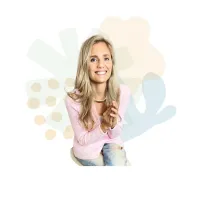All Recent Articles

Stop Fighting Your Female Body: 5 Science-Backed Biohacks That Work WITH Your Hormones
These five evidence-based biohacks can transform how you feel, sleep, and look by working with your body's natural rhythms (instead of against them).
As women, we're constantly told to push through, ignore our bodies' signals, and follow one-size-fits-all health advice (designed primarily, by the way, for men). But what if I told you that the most powerful health strategies involve working with your unique female physiology, not against it?
The emerging field of female-focused biohacking recognises that women's bodies operate differently - hormonally, metabolically, and neurologically. By understanding and leveraging these differences, we can optimise our energy, mood, sleep, and overall well-being in ways that feel sustainable and actually enjoyable.
Here are five research-backed biohacks that can create profound shifts in how you feel, starting today.

1. Get Morning Sunlight in Your Eyes (Circadian Rhythm Regulation)
The Strategy: Step outside for 10-15 minutes within the first 30 minutes of waking, without sunglasses, and let natural light hit your face directly.
The Science: This simple practice works through your body's master circadian clock, located in your brain's suprachiasmatic nucleus. When morning light hits specialised cells in your retina, it triggers a cascade of hormonal changes that optimise your entire day-night cycle.
Here's what happens physiologically:
Cortisol Optimisation: Morning sunlight exposure triggers an ideal cortisol spike early in the day, giving you natural energy and alertness while ensuring cortisol drops appropriately in the evening. This healthy cortisol rhythm is crucial for women's hormonal balance.
Melatonin Regulation: Your brain starts the 14-hour countdown to melatonin production, the hormone that makes you sleepy. Research shows that morning sunlight exposure significantly predicts better sleep quality that same night.
Mood and Cognitive Benefits: A study demonstrated how office workers who got morning bright light for just 5 days found it easier to make decisions and scored 79% higher on cognitive tests. Morning light also helps your body produce serotonin, a neurotransmitter crucial for mood regulation.
Implementation: Every morning, get outside without sunglasses, 10-15 minutes is sufficient. On cloudy days, aim for 15-20 minutes. Pair it with a morning walk for extra health benefits.

2. Experiment with Cycle Syncing (Infradian Rhythm Regulation)
The Strategy: Adjust your exercise intensity, food/nutrition, stress management, cold exposure practice, and self-care based on your menstrual cycle phases.
The Science: While social media has popularised cycle syncing, there is legitimate science around how hormonal fluctuations affect energy, mood, productivity, and stress resilience throughout your cycle.
The Phases:
During menstruation ('inner winter'), hormone levels, like oestrogen and progesterone, are low, often leading to lower energy, mood changes, and increased sensitivity to stress.
The follicular phase ('inner spring') brings rising oestrogen and increased energy levels and cold/stress tolerance.
Ovulation ('inner summer') typically corresponds with peak energy and confidence.
The luteal phase ('inner autumn') involves rising progesterone, reduced insulin sensitivity, potential PMS symptoms and lower stress tolerance.
Smart Implementation:
Track your cycle and notice your own patterns (use a thermometer to track temperature spikes indicating ovulation and luteal phase - 'symptothermal method').
During menstruation, consider gentler activities if you feel more sensitive, as this is when your body may benefit from extra rest and warmth.
Use the follicular phase for challenging new goals, and cold exposure, when energy tends to be higher.
Plan date nights, social outings and big work presentations during ovulatory phase.
Prioritise stress management and self-care during the luteal phase when PMS symptoms may emerge.

3. Practice Strategic Cold Exposure
The Strategy: Incorporate brief cold exposure through cold showers, ice baths, or cold water immersion 3-6 times per week, tailored to your individual tolerance and cycle.
The Science: Cold exposure triggers powerful physiological responses that can benefit women's health, though the research shows we may respond differently than men.
Key Benefits for Women:
Reduced cortisol levels: Unlike other stressors, brief cold water immersion actually decreases cortisol after the initial exposure, promoting better stress resilience.
Mood enhancement through increased dopamine and norepinephrine release.
Improved sleep quality, particularly beneficial for women in perimenopause and menopause.
Some studies show women may experience greater cognitive and metabolic benefits from cold exposure than men.
Increased metabolism from brown fat activation.
Female-Specific Considerations: Cold exposure can temporarily suppress reproductive hormones like FSH and LH, so women trying to conceive or with irregular cycles should be more cautious. However, women are actually more efficient at cold exposure—we feel the effects sooner, meaning we don't need temperatures as low or sessions as long to get benefits.
Safe Implementation:
Start with 30 seconds of cold water at the end of your shower.
Gradually work up to 1-2 minutes in an ice bath at 13-16°C (55-60°F) [note - for women there is no additional benefit to be in ice baths colder than 10°C/50°F].
Avoid cold exposure during the week before your period and during your menstrual phase.
Wait 8 hours after strength training to avoid blunting muscle protein synthesis (or do the ice bath session before any strength training).
To learn more, check out my 'Ice Baths & Cycle Syncing for Women' eCourse.

4. Optimise Your Gut-Brain-Hormone Axis
The Strategy: Support your microbiome through targeted nutrition and comprehensive testing to understand how your gut bacteria are influencing your mood, hormones, and overall health.
The Science: Your gut is home to trillions of bacteria that function as a virtual endocrine organ, producing hormones and neurotransmitters that directly impact your mental health and hormonal balance. This gut-brain-hormone connection is particularly crucial for women.
Your Gut Creates Your Mood: Recent research reveals that approximately 95% of your body's serotonin—the "happiness hormone"—is produced in your gut, not your brain. Gut bacteria also produce about 50% of your dopamine, plus GABA, norepinephrine, and other neurotransmitters that regulate mood, anxiety, and cognitive function.
The Estrobolome Connection: Your gut contains a collection of bacteria called the "estrobolome" that directly regulates your estrogen levels. These bacteria produce an enzyme called β-glucuronidase that activates estrogen, making it available for your body to use. When your microbiome is imbalanced (dysbiosis), this process is impaired, leading to:
Reduced circulating estrogen levels
Disrupted menstrual cycles
Increased PMS symptoms
Greater risk of hormonal conditions like PCOS and endometriosis
Mood disturbances and anxiety
Mental Health Impact: Studies show that women with depression often lack specific beneficial bacteria like Coprococcus and Dialister. Research found that people with higher stress resilience had microbiomes characterised by reduced inflammation and improved gut barrier integrity—essentially, a healthier gut meant better mental health.
Why Testing Is Essential: Unlike generic probiotics, understanding your unique microbiome through comprehensive stool analysis allows for targeted interventions. Modern microbiome testing can reveal:
Which beneficial bacteria you're missing
Inflammatory markers affecting your mood
Digestive function and nutrient absorption
Specific pathogenic bacteria disrupting your hormonal balance
Your gut's ability to produce essential neurotransmitters
My Clinical Approach: As a NutriPATH practitioner, I regularly order comprehensive microbiome analyses for my clients in Australia as part of my Glow & Flow Blueprint program. These detailed reports show not just what bacteria are present, but how they're functioning—giving us a roadmap for restoring optimal gut-brain-hormone communication.
Smart Implementation:
Consider comprehensive microbiome testing if you experience mood swings, digestive issues, or hormonal imbalances.
Include diverse fermented foods: kefir, sauerkraut, kimchi, and quality yogurt (this is my favourite one).
Focus on prebiotic-rich foods that feed beneficial bacteria: garlic, onions, asparagus, and green bananas.
Avoid unnecessary antibiotics and inflammatory foods (ie fried and highly processed foods) that disrupt microbial balance.
Work with a qualified practitioner to interpret results and create a personalised protocol.
The gut-brain-hormone axis represents one of the most exciting frontiers in women's health. By understanding and optimising this connection, we can address root causes rather than just managing symptoms.

5. Target Protein Distribution Throughout the Day
The Strategy: Focus on consuming adequate total daily protein (1.2-2.0g per kg of ideal body weight) distributed across meals, rather than obsessing over precise post-workout timing.
The Science: While the fitness industry has promoted the idea of a narrow "anabolic window" requiring immediate post-workout protein, recent research suggests this is far less critical than once believed.
What Current Research Shows:
Large meta-analyses examining protein timing show minimal benefits when total daily protein intake is adequate.
A 2020 study specifically in postmenopausal women found no difference in muscle gains whether protein was consumed immediately after exercise or several hours later.
Total daily protein intake matters far more than precise timing.
Female-Specific Protein Needs: Women's protein needs may actually be higher than previously thought, especially during hormonal transitions. Research suggests postmenopausal women should consume at least 0.8g per kg ideal body weight daily, with many benefiting from higher amounts.
Smart Implementation:
Aim for 20-30g of protein at each main meal:
Sample breakfast: ½ cup oats (5g) + 2 tbsp chia seeds (5g) + 1 cup soy milk (7g) + 2 tbsp almond butter (8g) = 25g (+ fruits of choice)
Sample lunch: 1 cup cooked quinoa (8g) + ½ cup black beans (7g) + ¼ cup nuts/seeds (6g) + 2 tbsp nutritional yeast (4g) = 25g (+ veggies of choice)
Sample dinner: 1 cup cooked lentils (18g) + ½ cup brown rice (3g) + 2 tbsp cashews (5g) = 26g (+ veggies of choice)
Include leucine-rich sources to maximise muscle protein synthesis: plant-based options include soy foods like tofu, tempeh, and edamame, legumes like lentils and navy beans, seeds like chia seeds and hemp seeds, quinoa, buckwheat, spirulina, nutritional yeast, almonds, amaranth, and chickpeas.
Don't stress about immediate post-workout protein unless you're training fasted.
Consider 4-5 evenly spaced protein feedings throughout the day for optimal muscle protein synthesis.
Your Starting Point
The beauty of these biohacks lies in their simplicity and synergy. Start with morning sunlight exposure —it's free, takes just 10 minutes, and creates a foundation that makes everything else more effective.
From there, start monitoring your menstrual cycle through taking your temperature every morning and adding the data in a period app (I use Flo). Add one strategy every 1-2 weeks. Notice how your body responds. Remember, the goal isn't perfection, it's progress toward feeling more energised, balanced, and in tune with your body's natural rhythms.
Your body has incredible innate wisdom. These biohacks simply help you listen to it more clearly and work with it more effectively. After all, you weren't designed to push through and power over your physiology - you were designed to flow with it.
Ready to dive deeper into evidence-based strategies for optimising your health as a woman? Join my Glow & Flow Blueprint - a 12-week transformational program to help women find & fix the root cause of their symptoms and attain the vibrant health they desire & deserve!


